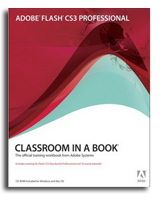
Yes, I both write and read computer books. In fact, I have quite a computer book library. A good title on my shelves is relished. Not every book is perfect, though. I’ve paid good money for books and been truly disappointed — and use that experience as motivation to write my own books better. Recently, I bought one of the Adobe Classroom in a Book titles. Man, what a let-down!
I paid $54.99 for Adobe Flash CS3 Professional Classroom in a Book. It’s a striking book, a tight 350 or so pages on heavy stock. Beautiful 4-color illustrations. Obviously the high price-point is due to the production values. No complaints there. But I didn’t buy an art book; I wanted to learn something.
When your desire is to learn something then obviously a title like Classroom in a Book would seem to suit you well. At first flip, the book appears to work on its theme: the chapters are organized into lessons. Each lesson is split up into careful steps. There are glorious figures, well-formatted call-outs, tips, and everything you’d expect. Again, it’s a handsome book.
Technically, the steps are flawless. Rarely have I made my way through a book and found that all the steps work. There were a few times that I got lost. Some of the steps are split up too tiny, which can be confusing. But that’s not the book’s big problem.
Where Classroom in a Book fails is that I didn’t learn anything. The book well-explains the how, but never bothers with the why.
For example, I’m told in several steps to “insert a key frame.” I know how to do that. The book tells me how, it explains where the key frame goes. It tells me what a key frame is. That’s good. But it never tells me why I need a key frame.
Now please don’t e-mail me to tell me about key frames. I know. But I know because I experimented on my own. For a $55 title that purports to be a “classroom” that’s disappointing. There was no homework in the book. I learned because I experimented on my own. But consider a student/reader who isn’t motivated. In that case, the student could work through the entire book and truly not learn how to do anything on their own. Their level of understanding would be minimal, which is where Classroom in a Book fails.
In my programming titles, I make an effort to teach the topic so that the reader understands it. Often I use the method of introducing mistakes on purpose. But more importantly, I want to ensure that all readers know why they do something, not simply that it be done.
I’ve only purchased one of the Classroom in a Book titles. At $55 a tome, they’re too expensive to me to risk my money trying to see whether another topic in the series may actually be taught, as opposed to recited.


When I’m going to buy a book, I spend a LOT of time checking it out first. I’ve found many that are like the one you mentioned… they are full of pictures and look very neat, but they don’t teach well. I bought your book “C All-in-one Desk Reference for Dummies” and its the best I’ve ever had. Your way of writing and teaching is excellent. I love it when you do mistakes on purpose and fully explain why it doesn’t work. I did every single exercise in the book, and it definitely helps understanding. Even your humorous writing helped me remembering where to look for things when I needed them. Now I feel like I fully understand the C language, and I’m now learning C++ (which it would’ve been really nice if you had a book on that too).
That’s how I like books: fun, motivating, technical and easy to understand.
Comment by samus250 — November 3, 2008 @ 4:34 pm
Thanks. I’m going to see what can be done about that C++ thing. I may just write the thing and put it up on the Internet for the hell of it. Enough people have asked. If publishers want to be stupid, I shan’t stop them. But thanks again for your comments!
Comment by admin — November 3, 2008 @ 4:40 pm
We recently bought Photoshop Elements 6 for the computer (ironically, about two weeks before the new Elements 7 came out… grr!), and we bought a couple of books: the Dummies book and the Missing Manual book. I’ve found them not very useful, but then again, I’m used to Photoshop, so I just needed to put things in a CS3ish manner and I was set. ANd, like samus250, I like my technology books to be fun and easy to understand. All of yours and Andy Rathbone’s Windows for Dummies series are excellent examples.
Comment by Douglas — November 4, 2008 @ 7:14 pm
The neat thing about Andy Rathbone’s Dummies books is that he gets it; he understands what a Dummies book is about, and he writes well about the subject. Andy is first and foremost a writer. Many computer books are written by technies who cannot write, and it shows.
I appreciate your comments!
Comment by admin — November 4, 2008 @ 10:52 pm